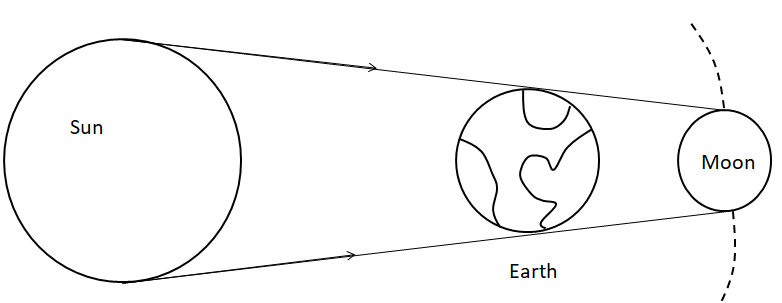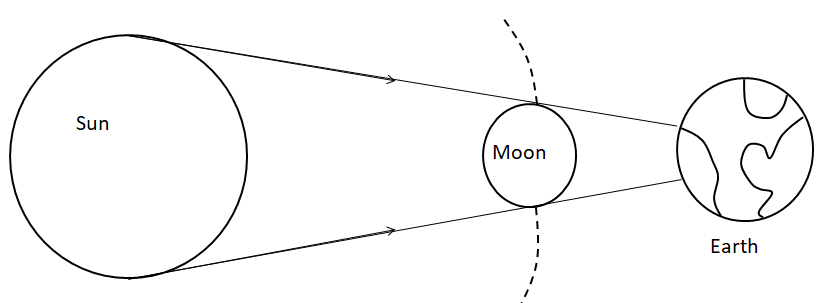
Lunar eclipse occurs when Earth comes in between Sun and the Moon. Solar eclipse occurs when the Moon comes in between Sun and Earth. This suggests that:
A. both eclipses occur on a new moon day.
B. solar eclipses occur on a new moon day and lunar eclipse occurs on a full moon day.
C. lunar eclipse occurs on a new moon day and a solar eclipse occurs on a full moon day.
D. Both eclipses occur on a full moon day.
Answer
583.2k+ views
Hint: The Lunar eclipse, refers to the eclipsing of the Moon by the Earth’s shadow and in a similar way, the Solar eclipse, refers to the eclipsing of the Sun by the Moon causing its shadow to fall on Earth.
Complete step-by-step answer:
An eclipse by definition, refers to an astronomical event when an astronomical object being viewed is temporarily over shadowed by another passing astronomical object such as a spacecraft or natural or manmade satellite. The shadow being cast on the astronomical object being viewed, maybe partial or complete; hence observing a partial eclipse or a full (or) complete eclipse.
For the current case of Lunar and Solar eclipse, the astronomical objects being considered are the Earth, the Sun and the Moon.
Let’s consider the case of the Lunar eclipse. Below is a diagram of the Lunar eclipse phenomenon.

Earth’s natural satellite, the Moon revolves around the Earth in an orbit. Similarly, the Earth revolves around the Sun in an orbit as well. Hence, during the process of revolutions, whenever the Sun, Earth and the Moon come in a straight line in the same order as mentioned, a Lunar eclipse occurs. The process happens as the sunlight emerging from the Sun, which is reflected by the moon due to which we see the moon at night, gets blocked as the Earth obstructs the sunlight. Hence, in this process the sunlight hits the Earth, which is supposed to hit the Moon during the Lunar eclipse process and hence, the Earth’s shadow falls on the moon causing the eclipsing of the moon. It’s important to know that a lunar eclipse can only occur on a full moon day.
Now, let’s consider the Solar eclipse. Below is a diagram of the Solar eclipse phenomenon.

As we know the Earth revolves around the Sun and the Moon in turn revolves around the Earth in an orbit as well. Similarly as in the Lunar eclipse process, during the revolutions of Earth around the Sun and the Moon around the Earth whenever the Sun, Moon and the Earth come in a straight line in the same order as mentioned, a Solar eclipse occurs. The process happens as the sunlight emerging from the Sun is blocked as the Moon orbiting the Earth obstructs the sunlight as it reaches the Earth. Hence, in this process the sunlight which is supposed to reach the Earth unhindered, instead hits the Moon causing the Moon’s shadow to fall on Earth and hence, the Solar eclipse occurs. It’s important to know that a solar eclipse can only occur on a new moon night.
Hence, Option B is the solution.
Note: A shortcut to remember why the lunar eclipse can only occur on full moon is because only then can you see the full moon being eclipsed as the Earth’s shadow is cast over it. Consecutively, by remembering that the reason for both lunar eclipse and solar eclipse are opposite to each other, since, the lunar eclipse only occurs on Full moon day. The solar eclipse can only happen on a new moon day.
Complete step-by-step answer:
An eclipse by definition, refers to an astronomical event when an astronomical object being viewed is temporarily over shadowed by another passing astronomical object such as a spacecraft or natural or manmade satellite. The shadow being cast on the astronomical object being viewed, maybe partial or complete; hence observing a partial eclipse or a full (or) complete eclipse.
For the current case of Lunar and Solar eclipse, the astronomical objects being considered are the Earth, the Sun and the Moon.
Let’s consider the case of the Lunar eclipse. Below is a diagram of the Lunar eclipse phenomenon.

Earth’s natural satellite, the Moon revolves around the Earth in an orbit. Similarly, the Earth revolves around the Sun in an orbit as well. Hence, during the process of revolutions, whenever the Sun, Earth and the Moon come in a straight line in the same order as mentioned, a Lunar eclipse occurs. The process happens as the sunlight emerging from the Sun, which is reflected by the moon due to which we see the moon at night, gets blocked as the Earth obstructs the sunlight. Hence, in this process the sunlight hits the Earth, which is supposed to hit the Moon during the Lunar eclipse process and hence, the Earth’s shadow falls on the moon causing the eclipsing of the moon. It’s important to know that a lunar eclipse can only occur on a full moon day.
Now, let’s consider the Solar eclipse. Below is a diagram of the Solar eclipse phenomenon.

As we know the Earth revolves around the Sun and the Moon in turn revolves around the Earth in an orbit as well. Similarly as in the Lunar eclipse process, during the revolutions of Earth around the Sun and the Moon around the Earth whenever the Sun, Moon and the Earth come in a straight line in the same order as mentioned, a Solar eclipse occurs. The process happens as the sunlight emerging from the Sun is blocked as the Moon orbiting the Earth obstructs the sunlight as it reaches the Earth. Hence, in this process the sunlight which is supposed to reach the Earth unhindered, instead hits the Moon causing the Moon’s shadow to fall on Earth and hence, the Solar eclipse occurs. It’s important to know that a solar eclipse can only occur on a new moon night.
Hence, Option B is the solution.
Note: A shortcut to remember why the lunar eclipse can only occur on full moon is because only then can you see the full moon being eclipsed as the Earth’s shadow is cast over it. Consecutively, by remembering that the reason for both lunar eclipse and solar eclipse are opposite to each other, since, the lunar eclipse only occurs on Full moon day. The solar eclipse can only happen on a new moon day.
Recently Updated Pages
Master Class 10 General Knowledge: Engaging Questions & Answers for Success

Master Class 10 Computer Science: Engaging Questions & Answers for Success

Master Class 10 English: Engaging Questions & Answers for Success

Master Class 10 Social Science: Engaging Questions & Answers for Success

Master Class 10 Maths: Engaging Questions & Answers for Success

Master Class 10 Science: Engaging Questions & Answers for Success

Trending doubts
The shortest day of the year in India

Why is there a time difference of about 5 hours between class 10 social science CBSE

Write a letter to the principal requesting him to grant class 10 english CBSE

What is the median of the first 10 natural numbers class 10 maths CBSE

The Equation xxx + 2 is Satisfied when x is Equal to Class 10 Maths

State and prove converse of BPT Basic Proportionality class 10 maths CBSE




